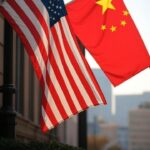Energy News Beat
The U.S.-China trade war, a rollercoaster of tariffs, retaliations, and negotiations, has been a defining issue for global markets since President Donald Trump’s first term. With recent developments signaling a potential resolution, investors in the energy, petrochemical, critical minerals, and steel sectors are eager to understand whether the tariff war is truly over and what it means for their portfolios. On June 11, 2025, President Trump announced a trade deal with China, pending final approval from both himself and Chinese President Xi Jinping. This article dives into the details of the agreement, its impact on key industries, and what investors need to know to navigate the new landscape.
— Karoline Leavitt (@PressSec) June 11, 2025
The U.S.-China Trade Deal: What We Know
The agreement, finalized after talks in Geneva, marks a significant de-escalation in the trade war that saw tariffs soar to triple-digit levels. Key points of the deal, based on recent reports and posts on X, include:
-
Tariff Reductions: The U.S. will impose a 55% tariff on Chinese imports, down from a peak of 145%, while China will apply a 10% tariff on U.S. goods, reduced from 125%. These rates, effective from May 14, 2025, reflect a 90-day truce to stabilize trade relations.
-
Critical Minerals and Rare Earths: China has committed to supplying rare earths and magnets upfront, addressing U.S. concerns over export restrictions on materials like samarium, gadolinium, and dysprosium, which are vital for defense, tech, and clean energy applications.
-
Educational Access: In a less conventional term, China will gain access for its students to U.S. educational institutions, a move that could foster long-term diplomatic ties but has sparked debate among investors wary of geopolitical concessions.
-
Trade Framework: The deal builds on a 2020 agreement, with U.S. officials like Treasury Secretary Scott Bessent emphasizing enforcement of prior commitments, such as Chinese purchases of American agricultural products.
However, the deal’s permanence is uncertain. Trump has warned that tariffs could rise again if China fails to comply, citing previous delays in issuing export licenses for rare earths. The agreement’s reliance on final approval from both leaders adds a layer of risk, as does the lack of clarity on addressing China’s state-driven economic model, a core U.S. grievance.
Petrochemicals: A Mixed Bag for Investors
The petrochemical sector, critical to energy markets, has been caught in the crossfire of the trade war. China’s dominance in chemical production and the U.S.’s reliance on imported intermediates have made tariffs a double-edged sword. The new agreement offers some relief but leaves lingering challenges:
-
Cost Relief: Lower tariffs (55% vs. 145%) reduce the cost of importing petrochemical intermediates from China, benefiting U.S. manufacturers of plastics, fertilizers, and synthetic materials. This could stabilize margins for companies like Dow Inc. and LyondellBasell, which have faced higher input costs.
-
Retaliatory Risks: China’s 10% tariff on U.S. goods, including petrochemical exports like liquefied natural gas (LNG) and polymers, remains a hurdle. U.S. exporters to China, such as ExxonMobil and Chevron, may see reduced competitiveness in Asian markets.
-
Investor Outlook: Petrochemical stocks may see short-term gains from reduced tariff costs, but volatility persists. Investors should monitor China’s compliance with the deal and potential disruptions in global supply chains, especially if tariffs escalate again. Firms with diversified markets outside China are better positioned.
Critical Minerals: A Strategic Win, but Challenges Remain
Critical minerals—lithium, rare earths, cobalt, and more—are the backbone of clean energy, defense, and tech. The trade war exposed U.S. vulnerabilities, with China controlling 70% of global rare earth production and 90% of processing. The agreement addresses some of these concerns but doesn’t fully resolve supply chain risks:
-
Rare Earth Access: China’s pledge to supply rare earths and magnets upfront is a boon for U.S. industries. Companies like MP Materials, which operates the only U.S. rare earth mine, could benefit from increased domestic demand and reduced reliance on Chinese processing.
-
Tariff Exemptions: Critical minerals like lithium and graphite remain exempt from some tariffs, supporting electric vehicle (EV) manufacturers like Tesla and battery producers. This helps maintain cost competitiveness in a sector already strained by global tariffs on steel and aluminum.
-
Long-Term Risks: The U.S. remains import-reliant for 40 of 50 critical minerals, with domestic production lagging due to high costs and permitting delays. Trump’s executive orders to streamline mining and deploy Defense Production Act funds aim to boost domestic supply, but scaling up could take years.
Investor Outlook: Critical mineral stocks, particularly those tied to rare earths (e.g., MP Materials, Lynas Rare Earths), may rally on improved supply certainty. However, investors should be cautious of geopolitical risks and the slow pace of U.S. supply chain diversification. ETFs like the Global X Lithium & Battery Tech ETF could offer exposure with less company-specific risk.
Steel: Higher Tariffs, Higher Costs
The steel industry has been a focal point of Trump’s trade policy, with tariffs aimed at protecting domestic producers like U.S. Steel and Cleveland-Cliffs. The latest developments have significant implications:
-
Doubling Tariffs: Trump doubled steel tariffs to 50% from 25%, effective June 2025, to counter cheap imports, particularly from China, which has displaced global supply. Aluminum tariffs also rose to 50%.
-
Domestic Boost: Higher tariffs shield U.S. steelmakers from foreign competition, potentially boosting revenues for companies like Nucor and Steel Dynamics. Trump’s promotion of a Nippon Steel-U.S. Steel partnership underscores his commitment to the sector.
-
Downstream Pain: Higher steel costs hit downstream industries, including automotive, construction, and energy infrastructure. EV manufacturers and pipeline companies face margin pressure, as steel and aluminum are key inputs.
Investor Outlook: Steel stocks are a strong bet for investors seeking exposure to domestic producers, with firms like Cleveland-Cliffs (noted in market updates) likely to benefit. However, industries reliant on steel imports, such as auto and energy equipment manufacturers, may face headwinds. Investors should weigh sector-specific risks and consider hedging with broader market ETFs.
Broader Investor Implications
The U.S.-China trade deal, while a step toward stability, doesn’t end the uncertainty that has rattled markets. Here’s how investors across energy and related sectors should approach the new reality:
-
Short-Term Relief: Reduced tariffs and restored rare earth supplies could lift sentiment in energy, tech, and manufacturing stocks. Premarket gains in retailers like Walmart and Nike, which rely on Chinese supply chains, suggest broader market optimism.
-
Persistent Volatility: The deal’s 90-day timeline and Trump’s history of tariff unpredictability keep markets on edge. The Tax Foundation estimates that tariffs will cost U.S. households $1,183 in 2025, potentially dampening consumer spending and energy demand.
-
Geopolitical Risks: China’s leverage over critical minerals and petrochemicals remains a strategic advantage. Analysts warn that Beijing’s export controls could resurface if negotiations falter, impacting defense and clean energy firms.
-
Energy Transition Challenges: The trade war has raised costs for clean energy projects, with tariffs on steel and aluminum increasing expenses for solar, wind, and battery infrastructure. While critical mineral exemptions help, the Carnegie Endowment notes that a 2025 recession could stall decarbonization efforts.
Critical Perspective: Is the War Really Over?
While the Geneva agreement has been hailed as a triumph of Trump’s dealmaking, some experts see it as a tactical retreat. Scott Kennedy of the Center for Strategic and International Studies argues that the U.S. backed down from maximalist tariffs without securing major concessions from China beyond a commitment to talk. China’s ability to redirect exports to Southeast Asia and maintain its economic model suggests it holds the upper hand. For energy investors, this raises questions about the long-term reliability of supply chains and the effectiveness of tariffs in reshaping global trade.
Moreover, the deal sidesteps deeper issues, such as China’s subsidies and dumping practices, which continue to distort markets for petrochemicals and minerals. Trump’s focus on domestic production is laudable, but the U.S. lacks the infrastructure to replace Chinese supply chains quickly. Investors should approach the “end” of the tariff war with skepticism, preparing for potential flare-ups.
What Should Investors Do?
-
Diversify Exposure: Focus on companies with strong domestic operations or diversified supply chains to mitigate tariff-related risks. ETFs covering clean energy (e.g., iShares Global Clean Energy ETF) or metals (e.g., SPDR S&P Metals & Mining ETF) offer balanced exposure.
-
Monitor Policy Shifts: Track Trump’s trade actions and China’s compliance closely. Platforms like X provide real-time sentiment—recent posts reflect optimism but highlight the deal’s fragility.
-
Bet on Domestic Producers: Steel and rare earth companies stand to gain from protectionist policies. Look for firms with government contracts or exposure to defense and clean energy.
-
Hedge Against Inflation: Tariffs contribute to higher costs, potentially fueling inflation. Consider inflation-protected assets or commodities like oil, which could benefit from supply constraints.
Conclusion
The U.S.-China trade deal announced on June 11, 2025, signals a pause in the tariff war, with lower tariffs and restored critical mineral supplies offering relief to the petrochemical, minerals, and steel sectors. For investors, this translates to short-term opportunities in domestic steel and rare earth stocks, tempered by risks in downstream industries and ongoing geopolitical tensions. While the deal is a step forward, it’s far from a definitive end to the trade war. Energy investors must stay vigilant, balancing optimism with caution as they navigate this complex landscape.
Energy News Beat will continue to track the U.S.-China trade saga and its impact on energy markets. Subscribe to the Energy News Beat Substack for updates, and share your thoughts in the comments.
The post Is the Trump Tariff War with China Over, and What Is the Final Impact to Investors? appeared first on Energy News Beat.









